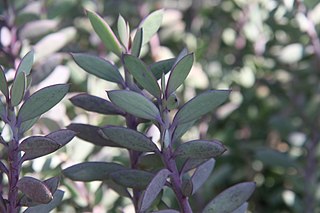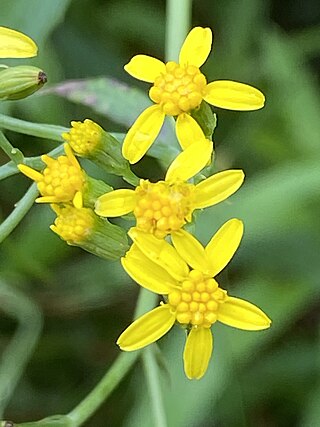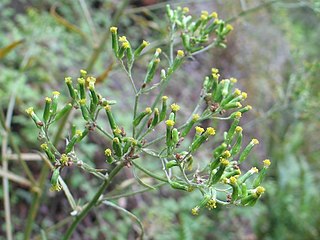
Senecio is a genus of flowering plants in the daisy family (Asteraceae) that includes ragworts and groundsels.

Senecio vulgaris, often known by the common names groundsel and old-man-in-the-spring, is a flowering plant in the family Asteraceae. It is an annual herb, native to the Palaearctic and widely naturalised as a ruderal species in suitable disturbed habitats worldwide.

Coreopsis lanceolata, commonly known as lanceleaf coreopsis, lanceleaf tickseed, lance-leaved coreopsis, or sand coreopsis, is a North American species of tickseed in the family Asteraceae.

Delairea odorata is a climber within the family Asteraceae that is native to South Africa. One of the two species in the genus Delairea, it was previously included in the genus Senecio as Senecio mikanioides. It is known as Cape ivy in some parts of the world (US) and German ivy in others. Other names include parlor ivy and Italian ivy.

Senecio squalidus, known as Oxford ragwort, is a flowering plant in the daisy family Asteraceae. It is a yellow-flowered herbaceous plant, native to mountainous, rocky or volcanic areas, that has managed to find other homes on man-made and natural piles of rocks, war-ruined neighborhoods and even on stone walls. These habitats resemble its well drained natural rocky homeland. The plants have spread via the wind, rail and the activities of botanists. The travels of this short-lived perennial, biennial, or winter annual make it a good subject for studies of the evolution and ecology of flowering plants.

Senecio eboracensis, the York groundsel or York radiate groundsel, is a flowering plant in the daisy family Asteraceae. It is a hybrid between a native and a non-native introduced species, which naturalised in England but the population failed to sustain itself. It was brought back by captive cultivation. It is a self-pollinating hybrid species of ragwort and one of only six new plant species to be discovered in either the United Kingdom or North America in the last 100 years.

Erechtites is a genus of flowering plants in the daisy family known commonly as fireweeds or burnweeds. They are native to the Americas and Australia, but some species are widely distributed weeds.
Fireweed is a perennial herbaceous plant in the willowherb family (Onagraceae).

Senecio angulatus, also known as creeping groundsel and Cape ivy, is a succulent flowering plant in the family Asteraceae that is native to South Africa. Cape ivy is a scrambling herb that can become an aggressive weed once established, making it an invasive species. It is grown as an ornamental plant for its satiny foliage and sweet-scented flowers.

Senecio tamoides, also known as Canary creeper, false grapevine, and parlor ivy, is a climbing member of the genus Senecio of the family Asteraceae that is native to Southern Africa. It is used as an ornamental plant for its showy yellow, daisy-like flowers in late autumn through to winter.

Senecio crassiflorus, in Portuguese: margarida-das-dunas, one of the native South American Senecio and an herbaceous dune dwelling perennial.

Senecio crassissimus, the propeller plant, vertical leaf or lavender steps, is a succulent species of flowering plant in the daisy family Asteraceae, and is endemic to the island of Madagascar off the east coast of Africa.

Senecio inaequidens, known as narrow-leaved ragwort and South African ragwort, is a species of flowering plant in the daisy family Asteraceae.

Senecio triangularis, known as arrowleaf ragwort, arrowleaf groundsel and arrowleaf butterweed, is a species of the genus Senecio and family Asteraceae.

Senecio hispidulus, the hill fireweed or rough groundsel, is a species of flowering plant in the daisy family. It is found in many parts of Australia.

Galtara extensa is a moth of the subfamily Arctiinae first described by Arthur Gardiner Butler in 1880. It is found on the Comoros and in Madagascar.

Erechtites glomeratus, common name New Zealand fireweed, or cutleaf burnweed, or fireweed or Cluster-headed fireweed, is a species of plant in the sunflower family. It is native to Australia and New Zealand, and also naturalized on the Pacific Coast of the United States.

Senecio linearifolius, commonly known as fireweed groundsel, is a species of flowering plant in the family Asteraceae. It is a small shrub with variable leaves, numerous heads of yellow flowers and grows in Tasmania, New South Wales and Victoria.

Senecio quadridentatus is native to Australia and New Zealand. In New Zealand it is known by its Māori name pahokoraka or pekapeka. Senecio quadridentatus is an annual or perennial herbaceous flowering plant in the family Asteraceae. It is also known as Erechtites quadridentata Labill by the synonyms.

Senecio minimus, commonly known as toothed fireweed and coastal burnweed, is a species of plant in the sunflower family. It is native to Australia and New Zealand, and also naturalized on the Pacific Coast of the United States.





















